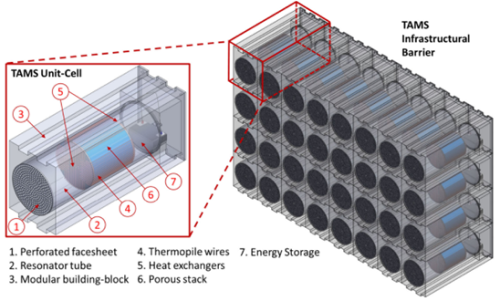BACKGROUND
The growing demand for self-sufficient systems has spurred the exploration of capturing lost residual energy. One alternative energy source is ambient acoustic energy from industrial and transportation noise pollution. Know methods include piezoelectric and electromagnetic techniques that suffer from low energy conversion efficiency and cost. To overcome these limitations, extensive research has focused on thermoacoustic devices, which operate without moving parts and are designed to harness acoustic energy for practical use. The market is seeking more affordable, lightweight, and efficient components for thermoacoustic energy devices.

SUMMARY OF TECHNOLOGY
Researchers at OSU have developed a Thermoacoustic Metastructure (TAMS) that utilizes an acoustothermo-electric transduction scheme, inspired by acoustic metamaterials. This innovative engineering solution has the potential for superior performance in terms of energy capture, durability, and environmental resilience compared to conventional piezoelectric materials. At the core of TAMS is a porous structure, or stack, which has intentionally tuned geometric and thermophysical properties to optimize energy creation. Additionally, Acoustic Metastructure barriers, like TAMS, serve not only to generate energy but also serve as sound barriers and noise pollution eliminators for our communities Noise pollution byproducts of urban spaces, particularly near highways, airports, and industrial facilities now have a positive return for neighboring communities. By harnessing the capabilities of additive and hybrid fabrication, OSU researchers aim to sculpt TAMS into a sustainable and efficient structure integrated within building materials and structures, poised to redefine the landscape of thermoacoustic devices and their multifunctional applications.
POTENTIAL AREAS OF APPLICATION
- Noise Reduction and/or Elimination
- Lost and Residual Energy Harvesting
- Power IoT Devices
- Battery Charging in Remote Areas
- Reduce or Eliminate Energy Infrastructure for Wireless Sensor Networks
MAIN ADVANTAGES
- More efficient environmental energy harvesting with no moving parts
- Minimal maintenance cost.
- Remote energy harvesting
- Sustainable and simple integrate.
STAGE OF DEVELOPMENT
Proof of Concept